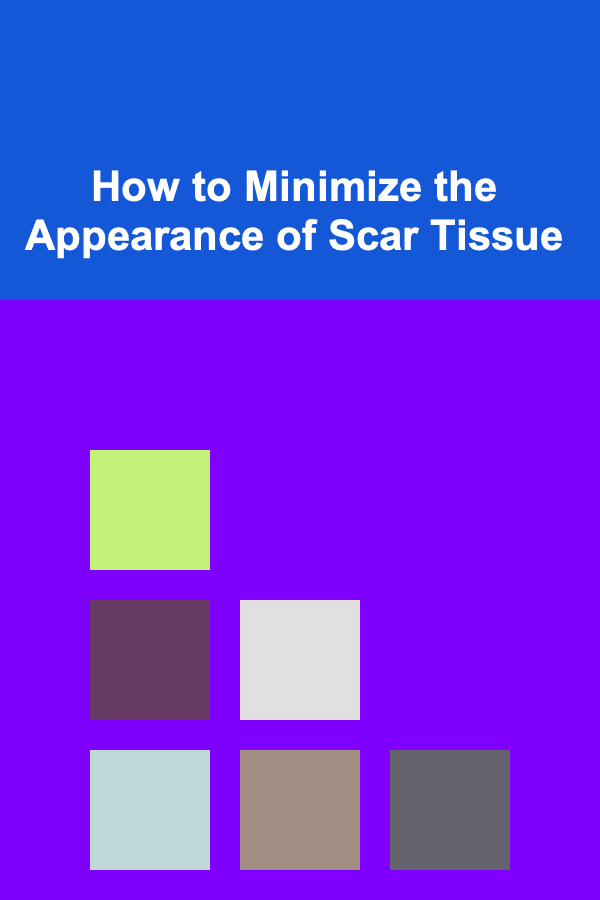
How to Minimize the Appearance of Scar Tissue
ebook include PDF & Audio bundle (Micro Guide)
$12.99$7.99
Limited Time Offer! Order within the next:

Scars are a natural part of the body's healing process, but they can often be a source of concern and self-consciousness. Whether you've had surgery, suffered an injury, or experienced a skin condition that resulted in scarring, understanding how to minimize the appearance of scar tissue can help you regain confidence and improve the overall look of your skin. In this article, we will explore the different types of scars, what causes them, and practical ways to minimize their appearance using both medical and natural methods.
Understanding Scar Tissue
Before diving into strategies for reducing the appearance of scars, it's important to understand what they are and how they form. Scars are a result of the body's natural healing process after an injury or trauma to the skin. When the skin is damaged, the body produces collagen fibers to repair the affected area. These fibers are often different from the surrounding tissue, leading to the formation of a scar.
Types of Scars
There are several different types of scars, each with unique characteristics and varying degrees of visibility. The most common types include:
- Hypertrophic Scars: These scars are raised and thickened but remain within the boundaries of the original wound. They often appear red and may flatten over time.
- Keloid Scars: Keloids are an overproduction of collagen that extends beyond the boundaries of the original wound. These scars are typically raised, thick, and may become itchy or painful.
- Atrophic Scars: These scars are depressed and occur when the skin does not produce enough collagen. They often appear as pitted or sunken areas, commonly associated with acne or chickenpox scars.
- Contracture Scars: Often caused by burns or large skin injuries, these scars can cause the skin to tighten, restricting movement. They can also affect the underlying muscles and nerves.
- Stretch Marks: A type of scar formed when the skin stretches too quickly, often due to rapid weight gain, pregnancy, or puberty. These scars appear as streaks on the skin, ranging in color from pink to purple to silvery-white.
Understanding the type of scar you are dealing with is essential, as different scars respond better to different treatments.
Causes of Scarring
Scars can be caused by a variety of factors, including:
- Surgical Procedures: Surgery leaves behind incisions, which may result in scars. The type of surgery, the location of the incision, and how well the skin heals play a role in the appearance of the scar.
- Injuries: Cuts, abrasions, and burns can lead to scars, particularly if the injury affects the deeper layers of the skin.
- Skin Conditions: Conditions like acne, chickenpox, and psoriasis can result in scars due to inflammation and tissue damage.
- Genetics: Some people are more prone to developing certain types of scars, such as keloids or hypertrophic scars, due to their genetic makeup.
- Infection: Infections that occur during the healing process can lead to more noticeable scarring.
Methods to Minimize the Appearance of Scar Tissue
There are a variety of methods to minimize the appearance of scar tissue, ranging from medical treatments to natural remedies. The choice of method will depend on the type and severity of the scar, as well as personal preferences.
1. Topical Treatments
Many people turn to topical treatments to reduce the appearance of scars. These treatments aim to improve skin texture, promote healing, and reduce inflammation.
Silicone Gel Sheets and Silicone Gel
Silicone gel sheets and silicone gel have been shown to be effective in reducing hypertrophic and keloid scars. Silicone works by hydrating the scar and creating a protective barrier that helps regulate collagen production, which can flatten and soften scars over time. These products are easy to apply and are typically worn for several hours or overnight. They can be purchased over-the-counter or prescribed by a doctor.
Scar Creams and Ointments
There are various over-the-counter creams and ointments specifically designed to treat scars. These products typically contain ingredients like vitamin E, allantoin, or corticosteroids. While the effectiveness of these products can vary, they may help with discoloration and overall appearance.
- Vitamin E: This antioxidant is often used in scar creams and oils for its healing properties. It helps nourish the skin and improve the texture of the scar.
- Corticosteroids: These are used to reduce inflammation and flatten raised scars, such as hypertrophic or keloid scars. They can be prescribed by a doctor or dermatologist.
Onion Extract
Onion extract is an ingredient found in many scar treatments. Studies have shown that onion extract can help reduce scar formation by reducing inflammation, improving skin regeneration, and inhibiting collagen overproduction. It is commonly found in topical gels or creams.
2. Professional Treatments
For more stubborn scars or those that do not respond to topical treatments, professional treatments may be necessary. Dermatologists and cosmetic surgeons offer several procedures designed to minimize scars.
Laser Therapy
Laser treatments use focused light energy to target scar tissue. Different types of lasers are used depending on the type of scar, and they work by stimulating collagen production, improving skin texture, and reducing redness or discoloration. Laser therapy is particularly effective for atrophic scars and keloid scars.
- Fractional CO2 Lasers: These lasers target deeper layers of the skin and are commonly used for deep scars like acne scars or surgical scars.
- Pulsed Dye Lasers: These are ideal for reducing redness in hypertrophic and keloid scars.
Laser treatments usually require multiple sessions, but they can significantly improve the appearance of scars with minimal downtime.
Microneedling
Microneedling, also known as collagen induction therapy, involves the use of tiny needles to create controlled micro-injuries in the skin. This stimulates the body's natural healing process, encouraging the production of collagen and elastin. Microneedling can be an effective treatment for both atrophic and hypertrophic scars, particularly acne scars. It is typically done in a dermatologist's office or spa setting.
Chemical Peels
Chemical peels involve applying a chemical solution to the skin to remove the outer layer, promoting new skin growth. This treatment can improve the appearance of superficial scars, including those caused by acne or sun damage. Depending on the strength of the peel, multiple sessions may be required.
Injectable Fillers
For depressed scars, such as atrophic scars, injectable dermal fillers can be used to restore volume to the skin. Fillers like hyaluronic acid can help raise the depressed area, making the scar less noticeable. These treatments provide immediate results but are temporary and may require touch-ups.
Steroid Injections
Steroid injections are commonly used for hypertrophic and keloid scars to reduce inflammation and flatten the scar. These injections are typically given in a series over several months. They can be particularly effective for raised scars and can help prevent further scarring.
3. Natural Remedies
Some people prefer to use natural remedies to minimize scar tissue. While these methods may not be as scientifically proven as medical treatments, they can offer gentle and holistic ways to care for your skin.
Aloe Vera
Aloe vera is known for its soothing and healing properties. It can help reduce inflammation, promote hydration, and support the skin's natural healing process. Applying fresh aloe vera gel or aloe-based creams to scars may help improve their appearance over time.
Coconut Oil
Coconut oil is rich in fatty acids, which can help moisturize the skin and promote healing. It also has anti-inflammatory properties that can reduce redness and irritation. Massaging coconut oil into scars may help improve their appearance and prevent them from becoming overly dry or tight.
Honey
Honey is a natural humectant, meaning it helps to retain moisture in the skin. It also has antibacterial properties that can prevent infections during the healing process. Applying honey to scars can help speed up healing and may reduce the risk of scar formation.
Lavender Oil
Lavender oil is known for its ability to promote skin regeneration. It contains antioxidants and anti-inflammatory compounds that may help reduce scar formation and improve the overall texture of the skin. Diluted lavender oil can be applied to scars for a gentle healing effect.
4. Prevention
Preventing scarring before it occurs is the best way to avoid visible scars. While not all scars are preventable, there are several steps you can take to minimize your risk of developing noticeable scars.
Keep Wounds Clean and Covered
Proper wound care is essential for preventing scarring. Clean the wound with mild soap and water and apply an antibiotic ointment to prevent infection. Keeping the wound covered with a sterile bandage will also help reduce the risk of scarring.
Avoid Picking at Scabs
Picking at scabs or scratching healing wounds can disrupt the healing process and increase the risk of scarring. Allow the skin to heal naturally and avoid irritating the area.
Protect Scars from the Sun
Sun exposure can darken scars and make them more noticeable. Applying sunscreen to the affected area, even after the wound has healed, can help protect the scar and prevent discoloration.
Stay Hydrated and Eat a Balanced Diet
Hydration and nutrition play a crucial role in skin healing. Drinking plenty of water and eating a diet rich in vitamins, minerals, and antioxidants can help support the skin's natural healing process and reduce scarring.
Conclusion
While it's impossible to completely eliminate scars, there are many ways to minimize their appearance and promote smoother, healthier skin. Whether you choose medical treatments like laser therapy and microneedling or prefer natural remedies like aloe vera and coconut oil, consistency is key to seeing results. By understanding the type of scar you have and selecting the right treatment options, you can take proactive steps to reduce scarring and improve your skin's appearance.

How to Choose Between Renting Furnished vs. Unfurnished Properties
Read More
How to Soundproof Your Apartment's Shared Walls with Minimal Effort
Read More
How To Master Lip Liner Application
Read More
How to Experience the Cultural Diversity of Malaysia
Read More
Identifying Finish and Length in Wine Tasting: A Comprehensive Guide
Read More
10 Essential Car Maintenance Checks Before a Road Trip
Read MoreOther Products

How to Choose Between Renting Furnished vs. Unfurnished Properties
Read More
How to Soundproof Your Apartment's Shared Walls with Minimal Effort
Read More
How To Master Lip Liner Application
Read More
How to Experience the Cultural Diversity of Malaysia
Read More
Identifying Finish and Length in Wine Tasting: A Comprehensive Guide
Read More